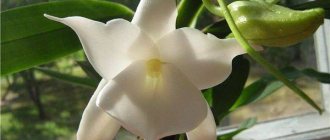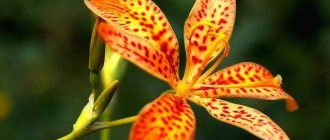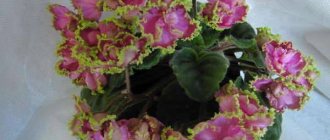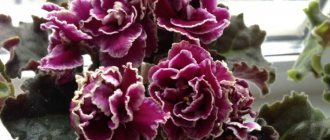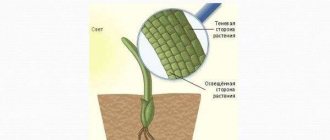Among the many species of orchids, phalaenopsis rightfully occupies a leading place in popularity among lovers of home floriculture.
This tropical, exotic flower, thanks to the achievements of breeders, is not so demanding on conditions and is unpretentious in care. But, without familiarizing themselves with the varietal characteristics and characteristics of growing each species or hybrid, some amateur gardeners experience difficulties growing this miracle plant at home.
Therefore, next we will talk about the varieties of orchids: Deborah, Hummingbird, Catalina, Concord.
Debora, Elegant Debora
Deborah.
Distinctive features
Botanical name: Phalaenopsis Debora (generic).
The roots are fleshy, 3 to 7 mm in diameter, green in color, covered with a layer of velamen, freely branching.
The leaves are oval, with a blunt tip, asymmetrical. The texture of the leaf plate is smooth, leathery. Before flowering, from 6 to 8 leaves are formed, measuring from 19 to 25 cm, with a width of about 7 cm and a thickness of a mature leaf of about 1.5 cm. The color of the leaves is green on the inside and outside.
On average, it produces 2-3 peduncles up to 65 cm in the adult state of the plant . Regular, average height – 55 cm.
The flowers have a typical shape for phalaenopsis - 3 petals and 3 sepals, which are trite. The petals are more pronounced than the sepals. The diameter of the flower in a well-developed plant is approximately 7-8 cm.
The lip is 3-lobed with 2 prominent calluses at the central node of the lateral lobes and at the base of the medial region. The lateral petals of the lip fold upward around the column; the middle extends forward and ends in two thread-like appendages at the apex.
Interesting! A distinctive feature of “Deborah” is her attitude towards black orchids. Although the issue is controversial, since the dark red color depends on the growing conditions and care.
History of the creation of the hybrid
For a large number of hybrids, determining the parental pair is almost impossible. One can only guess what varieties or species were involved in the creation. The Deborah orchid has much in common with the Goodhope variety . The difference is in the size of the flower and the slight predominance of red color.
According to some sources, the closest ancestors were " Doritaenopsis Ching Hua Spring " and " Doritaenopsis Sogo ". Regarding new hybrid forms, it can be assumed that the breeding of the hybrid occurred quite recently, more precisely at the beginning of the 21st century.
Doritaenopsis Ching Hua Spring is one of Deborah's possible parents.
In some Internet sources, “Debora” is called “Red Pioneer”. But there is no exact proof, and according to some descriptions, these are two different hybrids, although they are similar in color.
Common colors
Primary colors are red and violet , with a predominance of red. The edges of the petals have a white edge.
The color of the lip is quite difficult to describe - the base is yellow, ending in white. There is a purple line and some spots along the top edge. Edges with red or purple spots. The dominant color in the center is yellow. In addition, there is a varied combination of the same colors and shades on the lip blades.
Features, duration of flowering and dormant period at home
The inflorescence is vertical, slightly raised, with bilateral symmetrical flowers. The opening of flowers occurs sequentially, starting from the lowest.
Flowering duration occurs from 6 to 8 weeks. With proper care and adequate conditions, an adult plant blooms 2 times a year.
Since the opening of the inflorescences is sequential, the flowering period is quite long. And if there are 3-4 flower stalks, it can continue throughout the year.
Important! Phalaenopsis does not have a specific dormant period. Typically, this period begins immediately after flowering and ends after the plant has gained enough strength and energy for full development.
What is the difference between mini and midi orchids?
The main difference is the height of the plants and the size of the blooming buds. Mini orchids rarely exceed 20 cm, their peduncles are very fragile, the flowers are no more than 4 cm. Midi grow 55 cm, their buds reach 6-7 cm in diameter.
Features of flowering
Most varieties can bloom year-round; some produce buds in winter and spring. Up to 15 flowers can appear on peduncles. Due to their fragility, it is often necessary to install supports. Some varieties of decorative orchids bloom in lush clusters and are planted in hanging pots and baskets. Blooming buds do not fade for up to 30 days. To prolong flowering, orchid growers advise placing the pot with the flowering plant in a shaded place and watering it less often.
Concord
Concord is not the name of a variety or hybrid of an orchid, but a modern nursery engaged in the cultivation and cultivation of phalaenopsis.
Possessing vast areas and modern scientific methods of plant cultivation, the center grows a variety of hybrids for sale to wholesale buyers. That's why orchids come with the Concorde trademark.
Concord is a trademark and the name of the nursery.
Possible problems and difficulties
Even experienced gardeners sometimes encounter various problems when growing dwarf orchids.
Yellowing of leaves
This happens for various reasons:
- due to natural aging;
- with improper watering;
- with a lack or excess of fertilizers;
- for sunburn.
Dropping buds
An orchid can shed buds when:
- low lighting;
- sudden change in room temperature;
- long stay in a draft;
- violation of the watering regime.
Attention : orchids should not be placed next to bouquets and fruits, as due to the release of ethylene, they may drop their buds.
Wrinkling or rotting of leaf blades
Flower growers may encounter this problem for the following reasons:
- due to violation of the watering schedule;
- with poor ventilation of the room;
- in the absence of proper lighting;
- when overfeeding the plant with fertilizers.
Consequences of a lack of sunlight
For tropical mini-flowers, the sun is the key to good health. And in the absence of sufficient sunlight, the plant can:
- refuse flowering;
- discard the formed buds;
- change leaf color;
- stop growing.
Drafts
All orchids, and not only miniature ones, are afraid of drafts. Since this leads to hypothermia of their roots and leaves. As a result, the plant will: drop its buds, refuse to bloom, and stop growing.
Reaction to excess nitrogen
An excess of nitrogen threatens the plant with intensive growth of green mass. As a result, the flower will not bloom for a long time. Also, an excess of nitrogen threatens plants: cracking of leaves, damage by diseases and pests.
Catalina
Distinctive features, external characteristics
One of the relatively miniature phalaenopsis hybrids with unusual round flowers . Botanical name: Phalaenopsis Catalina.
The root system is well developed. Aerial roots branch well. The roots are up to 7 mm thick, dense and fleshy, green in color.
The leaves are oval-shaped, asymmetrical relative to each other. Size 12-20 cm long, 8-10 cm wide. The color of the leaf plate on both sides is green.
It usually produces 2 peduncles with good branching. The height of the flowering arrow in an adult and well-developing plant can reach up to 50 cm.
Flowers have a classic phalaenopsis shape - 3 petals and 3 sepals. The petals are round in shape, with a diameter of 5-6 cm. The lip is three-lobed, small in size, with a yellow-orange ending.
History of the creation of the hybrid
The origin and history of hybrid forms is always very long and sometimes confusing. The Catalina orchid originates from Phal. Flora Delight × Phal. Sheila Greene. It is quite difficult to establish the entire pedigree branch. Many varieties have evolved from the hybrid
- Phalaenopsis Catalina Mulanax;
- Phalaenopsis Catalina Naugle;
- Phalaenopsis Etherege Catalina;
- Multiflora "Catalina" and others.
What colors are there?
The colors of the varieties are not very different from each other. The difference comes down to shades and possible lines and inclusions. Primary colors are lilac or light purple.
Catalina's main color is shades of purple.
Features, duration of flowering and dormant period at home
Flowering is common for phalaenopsis. It can last almost all year round. The flower blooms on average from 4 to 8 weeks.
There is no specific resting stage for Catalina.
Types and varieties
Breeders have developed many species of miniature tropical plants. New products appearing every year have different shades of inflorescences and differ in the duration of flowering. Orchid growers share photos of dwarf orchids. The most popular varieties:
| Varieties | Distinctive features |
| Pink | The name of the variety was given by the color of the flowers. This is one of the smallest orchids. The size of the leaf blades usually does not exceed 8 cm, and the length of the peduncles is 20 cm. Up to 15 small inflorescences bloom on one plant, their size is about 3 cm. |
| Mini Mark | A hybrid bred from the dwarf variety Micro Nova and phalaenopsis. Its flowers are white, with pink or yellow specks. Lip color is brownish. The leaf plates of the Mini Mark orchid are of a rich shade, up to 15 cm long. |
| Multiflora | A feature of multiflora is the appearance of a large number of medium-sized buds. Plants often branch heavily, and their flower stalks do not stop growing even during the flowering period. |
| Luddeman | The variety is named after the French breeder. Height - up to 20 cm. 6-7 buds of unusual striped color simultaneously bloom on one peduncle. Their color is deep purple, with brownish tips. |
| Philadelphia | The hybrid was obtained based on several varieties of phalaenopsis. Its leaf plates are distinguished by a silver-green, “marble” color, and the petals are purple. |
| Cattleya | This is a popular variety of mini orchids. One of the most common varieties is called “Walkera”. Its leaves are dark green, about 10 cm long. And the inflorescences are large in size, up to 8 cm. |
| Hummingbird | A distinctive feature is the shape of the flowers, similar to a star. Outwardly, it resembles a hummingbird. Peduncles are miniature, up to 12 cm in length. They produce several flowers that do not fade for up to 45 days. |
| Cymbidium | One of the most unpretentious small orchids. Its flower stalks, about 15 cm high, grow among narrow, long leaf blades. White or pink flowers bloom on them, emitting a delicate aroma. |
Rules of care
Optimal conditions of detention
The main requirements for growing any phalaenopsis hybrids are the creation of the necessary conditions and proper care. They are the guarantors of the full development, health and quality of orchid flowering. These include:
- Lighting. The tropical plant, although created by man, has not lost its ancestral genes and needs a sufficient amount of daylight. It should be at least 10 hours a day. If necessary, especially in winter, it is enough to supplement it with phytolamps;
- Temperature. In home growing conditions, temperature does not particularly affect growth and development. It is important to observe the differences between night and day temperatures. This indicator should be about 4-5° C. The temperature range for cultivation is quite wide, but should not fall below 5° and above 30° C. Daytime temperatures can be considered optimal at 24-26° C and at night 19-21° C;
- Humidity. In most cases, humidity meets the requirements - 40-80%. But during the cold period, when the heating devices are turned on, orchids may experience some inconvenience. Therefore, additional, gentle spraying is carried out or a container of water is installed next to the plant.
Additional conditions include the inadmissibility of drafts and hypothermia.
Important! Phalaenopsis should be positioned so as to prevent direct sunlight from hitting it. The light should be diffused.
Watering and fertilizing
These are two most important processes that affect not only the development and splendor of flowering, but also largely its health.
In the spring and summer seasons, watering is carried out approximately once a week on the substrate, avoiding oversaturation with moisture. Soaking is not recommended.
Watering is carried out with soft, pH-neutral, warm water in the morning to avoid rapid evaporation during the hotter daytime hours. The frequency depends on the color of the roots. The optimal time for watering is considered to be the silver-gray color of all the roots of the plant.
Determining the need for watering.
In the autumn-winter period, the watering procedure is reduced by half or even three, depending on the temperature and humidity in the room.
Fertilizing is carried out only with fertilizers for orchids at every third watering, with a reduced concentration of 2-4 times from the recommended instructions. During the dormant period, feeding stops.
Stimulation of flowering
Stimulation for repeated or long-term dormant plants is usually carried out on an adult orchid. The young plant is allowed to gain energy and strength.
This procedure is carried out using the stress method . Watering and fertilizing are significantly reduced or completely eliminated and the flower is placed in a cool place, with a temperature of about 15-18 ° C for 2-3 weeks. And then it is put in its usual place.
Stress stimulation forces the plant to stimulate its genetically inherent processes - the production of offspring. As a result, the orchid produces a peduncle and buds.
Growing problems
Hybrids adapted for growing at home do not cause any particular problems for the grower if the minimum care requirements are met.
Important! The main thing is to follow the rules and alternation of watering.
Disease Prevention
Like any other plant, orchids are susceptible to various diseases and pests. The basis for prevention from misfortunes is the creation of the necessary conditions and proper care. It is for these reasons that 90% of troubles occur.
Reproduction
Breeding these orchids occurs in the same way as ordinary ones. The process has several ways:
- Seeds. In this case, it is necessary to artificially pollinate the flower, collect the seeds, process them and germinate them. The effectiveness of this method is quite high. However, it is necessary to spend a lot of effort and time. Only after 5–7 years will the orchid bloom for the first time.
- By cuttings. In this case, you need to cut the peduncle into several 10 cm pieces. Then they need to be placed in water and under a small greenhouse. After about 3 months, some of the cuttings will produce roots.
- Dividing the bush. This is the most popular method of propagating orchids. It is necessary to divide the plant into two parts with a sharp knife, and treat the cut area with activated carbon.
Mini orchids also reproduce by babies (naturally). But this is not true for all varieties; they can only be obtained under ideal care conditions.
Today, mini orchids are often grown indoors. They are small in size, which is appreciated by florists. In the natural environment, their analogues can reach one meter in height. In principle, this is an unaffordable luxury for most apartments. Then there would be only one orchid with leaves up to 90 cm on the windowsill. In this case, it is possible to enjoy the flowering of a tropical plant at home.
5/5 — (1 vote)
Main features of proper landing
How to choose soil?
The basis of the soil, or as it is commonly called for orchids, the substrate, is pine bark. A ready-made, completely correctly composed substrate can be easily purchased in specialized stores.
More experienced orchidists prefer to make it themselves, observing certain proportions. What is included in the main components of the substrate:
- pine bark with a fraction of 1.5-2 cm;
- charcoal;
- inert materials: vermiculite, polystyrene foam, perlite, expanded clay (not recommended);
- sphagnum moss;
Some gardeners use coconut chips, fern and other filter components.
Capacity
Since the root system of phalaenopsis is involved in photosynthesis , it needs lighting. Therefore, the container must transmit light well. From rotting of the root system and its good drying, good ventilation of the substrate and root part is required. In this regard, the flower pot must have holes not only for drainage, but also on the side walls.
The optimal container is considered to be a plastic transparent pot , in which you can easily make the required number of holes. There are ready-made containers for orchids on sale that satisfy all the needs for the full development of the plant.
Options for orchid pots.
Technology and nuances of transplantation
Phalaenopsis has a negative attitude towards transplants. Therefore, it is transplanted only in exceptional conditions:
- decomposition and compaction of the substrate (every 2-3 years);
- too crowded for the root system;
- diseases or a large number of pests in the root part.
Typically, replanting occurs after flowering, when the orchid enters a dormant state.
The plant is carefully removed from the old container so as not to damage the roots. The roots are cleaned of the old substrate, damaged and dried roots are cut off. The cut areas are treated with activated carbon and dried.
A drainage made of inert materials about 2 cm thick is placed at the bottom of a new container. The dried root part is lowered into the pot and filled with bark and charcoal.
It is carefully compacted. In this case, the root collar should not be under the substrate to avoid rotting during watering. If necessary, mulch with moss. This is followed by the standard care process - watering, fertilizing and sufficient light.
Dwarf orchids Mini houses
Dwarf orchids are a copy of their relatives, and practically do not differ from them in external features, except for their small stature. They are found not only in houses and greenhouses, but also in nature. Since with such small sizes, it is easier for the flowers to find a sunny corner in the crown of the tree.
Attention: a mini orchid is a flower that, when grown, can fit in the palm of your hand.
Their features include:
- small height. Usually not exceeding 20 cm;
- small flower sizes;
- small leaves up to 20 cm;
- high content requirements.

